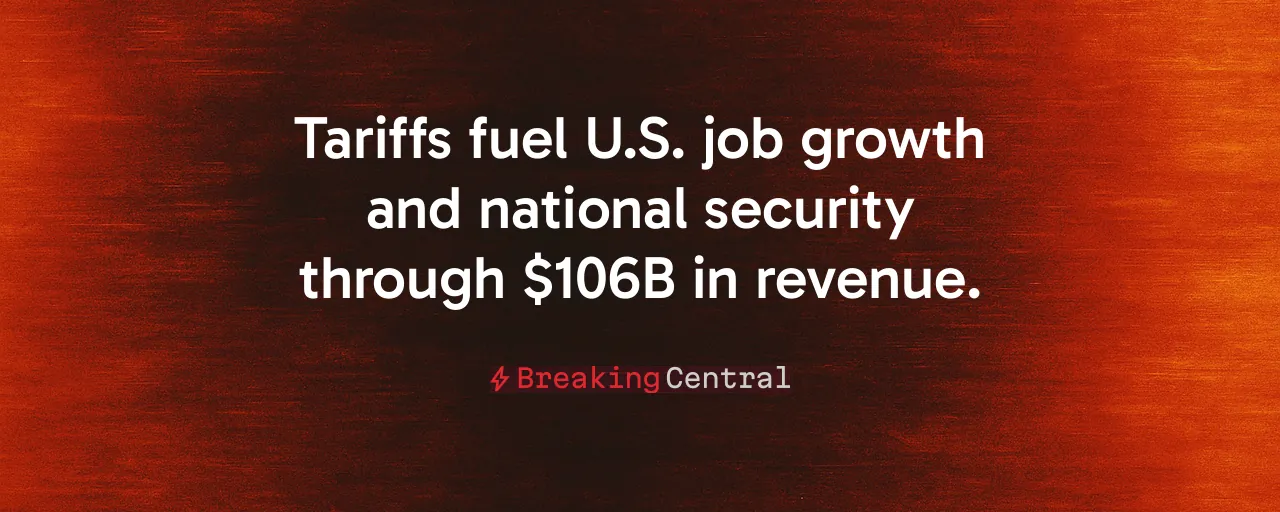A New Era of Economic Power
The U.S. Customs and Border Protection agency announced it has collected $106.1 billion in revenue since President Trump took office, with $81.5 billion tied directly to new tariffs. This milestone signals a bold shift in trade policy, one that places American workers and national security at the forefront. Rather than accepting decades of job losses to foreign competitors, the administration is using tariffs to level the playing field. The revenue fuels domestic priorities, from infrastructure to border enforcement, while sending a clear message: America will no longer subsidize its adversaries.
This approach revives a proven strategy. For over a century, tariffs funded the federal government, building the nation's early infrastructure and industries. Today's policies echo that legacy, aiming to restore self-sufficiency in critical sectors like steel and manufacturing. The stakes are high. Dependence on foreign goods, especially from nations with opposing interests, has left the U.S. vulnerable. Tariffs offer a corrective, encouraging companies to bring production back home.
Enforcement That Delivers Results
The success of this trade agenda hinges on execution. CBP reports a 99.5 percent collection rate, a testament to rigorous enforcement. By auditing over 35,000 high-risk shipments, the agency secured an additional $16.3 billion, cracking down on schemes like undervaluation and transshipment. Advanced tools, such as the Automated Commercial Environment system, allow CBP to flag discrepancies in real time, ensuring no revenue slips through the cracks.
This precision matters. Every dollar collected strengthens the nation's ability to invest in itself. Domestic manufacturers, long undercut by cheap imports, gain breathing room to compete. Steel and aluminum plants, revitalized by targeted tariffs, have added jobs in states like Ohio and Pennsylvania. Meanwhile, the revenue bolsters border security, with CBP attributing a 95 percent drop in southern-border crossings partly to enhanced resources. These gains show what's possible when trade policy aligns with national priorities.
Protecting Workers and Industry
Tariffs do more than raise revenue; they protect American workers. For decades, unchecked imports flooded markets, shuttering factories and hollowing out communities. The administration's 10 percent baseline tariff, alongside higher rates on strategic sectors, counters this trend. Domestic manufacturers and unions, key stakeholders in this fight, praise the measures for giving U.S. products a fighting chance. Companies are rethinking supply chains, with some reshoring production to avoid duties.
Historical precedent supports this approach. In the 19th century, Republican-led tariff policies nurtured industries, transforming the U.S. into an economic powerhouse. Today's strategy builds on that foundation, prioritizing sectors critical to national security. By reducing reliance on foreign semiconductors, medical supplies, and energy, the U.S. can safeguard its future. The alternative, continued dependence, risks economic and strategic weakness.
Navigating Challenges With Resolve
Critics argue tariffs raise consumer prices, and the concern isn't baseless. Studies show import costs often pass through to buyers, with low-income households feeling the pinch most. The solution involves refining tariffs rather than abandoning them. Targeted exemptions for essential goods and tax credits for families can ease burdens while preserving the broader strategy. Tariffs generate revenue without directly tapping American paychecks, offering a smarter fiscal tool than broad tax hikes.
Another hurdle is legal. Courts are reviewing whether presidential tariff powers, often tied to national-security laws, overstep constitutional bounds. Congress, too, is debating bills to reclaim tariff-setting authority. These tensions demand careful navigation. Strengthening CBP's enforcement tools and linking revenue to visible public benefits, like road repairs or veteran services, can build broader support and blunt opposition.
A Vision for Lasting Prosperity
The tariff agenda is a long-term investment in America's strength. By generating $106 billion and counting, it provides resources to rebuild industries, secure borders, and reduce foreign dependence. The policy's success lies in its focus on tangible outcomes: jobs created, factories reopened, and communities stabilized. CBP's enforcement ensures the system works, delivering revenue and fairness in equal measure.
Challenges remain, from consumer costs to legal disputes, but the path forward is clear. Expanding targeted tariffs, enhancing enforcement technology, and tying revenue to domestic priorities will cement these gains. Negotiating trade deals that lock in reciprocal duties can further level the global playing field. This strategy focuses on building an America that stands tall, economically and strategically.
Ultimately, this trade policy reflects a core truth: a nation's strength begins at home. By prioritizing its workers, industries, and security, the U.S. is charting a course for prosperity that future generations will inherit. The $106 billion collected so far is just the start. With resolve and refinement, tariffs can anchor a new era of American greatness.
